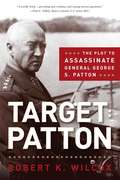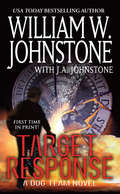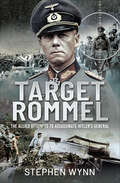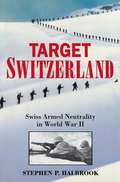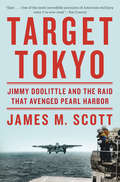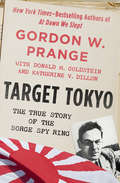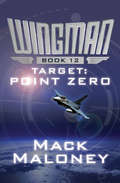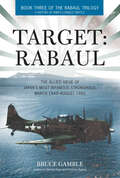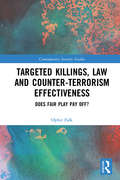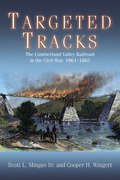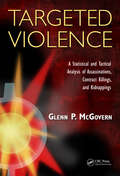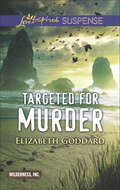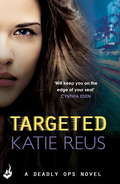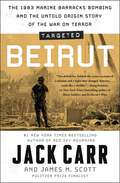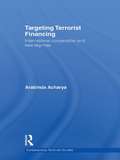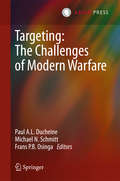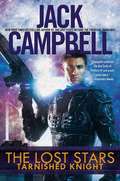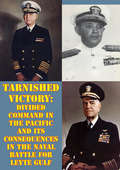- Table View
- List View
Target Omega: A Thriller
by Peter KirsanowA propulsive, high-stakes debut thriller where one extraordinary operator holds the key to saving the world from Armageddon. All he needs to do is stay alive. Buried deep in the US defense and special forces architecture is an elite, ultra-black unit, created expressly to prevent weapons of mass destruction from falling into the hands of terrorists and rogue regimes. Their covert, surgical strikes eliminate grave threats so the rest of America can sleep without fear. Until now. After returning from a successful operation in Pakistan, the entire team is assassinated within forty-eight hours. Only their leader, Michael Garin, survives. As the sole survivor and chief suspect of the attack, Garin finds himself on the run from Iranian intelligence operatives bent on tracking and killing him. Even Garin’s own government appears to have turned against him, sending a lethal sniper from the vaunted Delta Force to eliminate the threat they think he’s become. With enemies coming at him from every direction, Garin’s fight for survival becomes part of a larger conspiracy unfolding on the world’s stage: a catastrophic attack—precipitated by escalating tensions in the Middle East—that will shift the balance of power and plunge the United States of America into oblivion.From the Hardcover edition.
Target Patton: The Plot To Assassinate General George S. Patton
by Robert K. WilcoxThe death of General George S. Patton is shrouded in mystery. While officially the result of an unfortunate car accident, the evidence points to a far more malevolent plot: murder. So says investigative and military journalist Robert K. Wilcox in his book: "Target: Patton: The Plot to Assassinate General George S. Patton." Written like a WWII spy thriller and meticulously researched, "Target: Patton" leads you through that fateful December day in 1945, revealing a chilling plan to assassinate General Patton. Backing up this shocking story with facts, photos, and eyewitness statements, Wilcox reveals long-hidden documents and accounts that explain how secrets Patton knew--and his strong anti-Soviet views--may have cost him his life.
Target Patton: The Plot to Assassinate General George S. Patton (World War II Collection)
by Robert K. WilcoxThe death of General George S. Patton is shrouded in mystery. While officially the result of an unfortunate car accident, the evidence points to a far more malevolent plot: murder. So says investigative and military journalist Robert K. Wilcox in his book: Target: Patton: The Plot to Assassinate General George S. Patton. Written like a WWII spy thriller and meticulously researched, Target: Patton leads you through that fateful December day in 1945, revealing a chilling plan to assassinate General Patton. Backing up this shocking story with facts, photos, and eyewitness statements, Wilcox reveals long-hidden documents and accounts that explain how secrets Patton knew; and his strong anti-Soviet views;may have cost him his life. Not only does Wilcox reveal how, why, and when, he also names names; exposing little-known stories and secrets of such key players as General "Wild Bill" Donovan, the storied head of the OSS (the predecessor to the CIA); an OSS assassin; an Army intelligence agent; and even Josef Stalin himself. Target: Patton challenges readers to look at the evidence and question the conventional wisdom. After reading it, few will think of General Patton; or the circumstances surrounding his death; in the same way again.
Target Response:
by William W. Johnstone J.A. JohnstoneWho Is Killing The Army's Killer Elite?The attacks strike like lightning, a murder blitz targeting America's most ultra-secret organization, the Army's clandestine assassination arm known as the Dog Team. Without warning, Dog Team operatives are being systematically slaughtered, decimating the republic's last, best hope against those who would destroy our freedom.Surviving the initial onslaught are two of the Team's master assassins, Major Joe Kilroy and Captain Steve Ireland. Now, this supreme warrior duo gathers the remnants of the unit to form the Dog Team's Death Squad to unleash their counterstrike: complete annihilation of a shadowy global cartel owing allegiance to no flag, with a private army of international mercenaries. . .The darkest and deadliest secret war that ever rocked a nation is about to begin.
Target Rommel: The Allied Attempts to Assassinate Hitler’s General
by Stephen WynnFrom a German perspective, the highly decorated and well respected General Erwin Rommel was one of their biggest and brightest assets: a military strategist who thought ‘outside of the box’, a tactic which more than once either brought him an unexpected victory, or saved him from almost certain defeat. His reputation had been gained early in the Second World War, whilst commander of the 7th Panzer Division during the invasion of France, and as the commander of German forces during the North African campaign between 1941 and 1943. Such was his influence not only as a military strategist but on the morale of the men who served under him, as well as that of the German public, that the British government decided it needed to make concerted efforts to try to capture or eliminate him, making Rommel the only German officer of the Second World War that the allied authorities were prepared to put such time, manpower and commitment into eliminating. Two operations were put in to place to try to achieve this: Operation Flipper in November 1941, and Operation Gaff in July 1944. Both operations failed for different reasons, but just three months after the latter of the two operations, Rommel was dead, forced to commit suicide by Adolf Hitler for his part in the attempt to assassinate him on 20 July 1944. Such was the level of Rommel’s popularity and importance that the Nazi authorities reported the cause of his death to be injuries sustained in an attack on his staff car by enemy aircraft. Indeed, it was only after the war that the truth behind his death was revealed.
Target Switzerland: Swiss Armed Neutrality in World War II
by Stephen P. HalbrookA fascinating and enlightening explanation of the dilemma Switzerland found itself in during the 1930's and 1940's. --Publishers Weekly
Target Tokyo: Jimmy Doolittle And The Raid That Avenged Pearl Harbor
by James M. ScottFinalist for the 2016 Pulitzer Prize in History "Like Lauren Hillebrand's Unbroken…Target Tokyo brings to life an indelible era." —Ben Cosgrove, The Daily Beast On April 18, 1942, sixteen U.S. Army bombers under the command of daredevil pilot Jimmy Doolittle lifted off from the deck of the USS Hornet on a one-way mission to pummel Japan’s factories, refineries, and dockyards in retaliation for their attack on Pearl Harbor. The raid buoyed America’s morale, and prompted an ill-fated Japanese attempt to seize Midway that turned the tide of the war. But it came at a horrific cost: an estimated 250,000 Chinese died in retaliation by the Japanese. Deeply researched and brilliantly written, Target Tokyo has been hailed as the definitive account of one of America’s most daring military operations.
Target Tokyo: The Story of the Sorge Spy Ring
by Gordon W. Prange Donald M. Goldstein Katherine V. DillonFrom the New York Times–bestselling authors of Miracle at Midway: A thrilling account of one of World War II&’s most legendary spies. Richard Sorge was dispatched to Tokyo in 1933 to serve the spymasters of Moscow. For eight years, he masqueraded as a Nazi journalist and burrowed deep into the German embassy, digging for the secrets of Hitler&’s invasion of Russia and the Japanese plans for the East. In a nation obsessed with rooting out moles, he kept a high profile—boozing, womanizing, and operating entirely under his own name. But he policed his spy ring scrupulously, keeping such a firm grip that by the time the Japanese uncovered his infiltration, he had done irreversible damage to the cause of the Axis. The first definitive account of one of the most remarkable espionage sagas of World War II, Target Tokyo is a tightly wound portrayal of a man who risked his life for his country, hiding in plain sight.
Target for Tonight: Flying Long-Range Reconnaissance & Pathfinder Missions in World War Two
by Denys A. BraithwaiteThe posthumous memoirs of a World War II Pathfinder pilot and Distinguished Flying Cross recipient who flew target-marking missions in enemy territory. Denys A. Braithwaite was born of a well-to-do Yorkshire family and joined the Auxiliary Air Force on his eighteenth birthday in 1939. On the occasion of Chamberlain&’s speech to the British nation on September 3, the situation changed dramatically and from being a &“super weekend club,&” his squadron was assigned coastal patrol duties. In October he was posted to Peterborough to learn to fly with the regular RAF. There followed a period of convoy protection flying Blenheims and then flying with the meteorological flight based at Bircham Newington on the Norfolk coast. Here he flew a Gloster Gladiator with a flight that had the reputation of &“flying even when the birds wouldn&’t.&” Now a Squadron Leader, Braithwaite became acquainted with the legendary de Havilland Mosquito and flew long-range weather reconnaissance flights (PAMPA) under the control of Coastal Command. These patrols involved a lone aircraft flying deep into enemy territory to observe the meteorological conditions in advance of bombing raids or naval action. PAMPA Flight 1409 moved to Oakington and transferred to Bomber Command and operated under the command of Air Commodore Donald Bennett and became one of the elite Pathfinder units. Braithwaite&’s lengthy and successful tour included many exciting episodes described here in thrilling detail. After being transferred to the United States, Braithwaite was posted to India where he contracted a tropical disease that ended his flying career. The recipient of the Distinguished Flying Cross, Braithwaite died before being able to see his memoirs in print.
Target: Point Zero (Wingman #12)
by Mack MaloneyA crazed terrorist looms high above the Earth, and pilot Hawk Hunter must take him down: &“The best high-action thriller writer out there today, bar none&” (Jon Land). It&’s been years since the Soviet Union used its last dying breath to rain nuclear annihilation upon the United States. Now, freedom&’s greatest enemy is no longer the entire Russian government; it&’s a single Russian man: Viktor Robotov, a demented genius, is an expert at inciting mayhem. Twice he has manipulated global politics to produce catastrophic wars, and twice the pilot Hawk Hunter has thwarted him. But Robotov&’s latest scheme will force Hunter to fly higher than he ever has before—all the way to outer space. On a state-of-the-art Russian shuttle, Robotov launches himself into orbit, planning to collect the derelict laser satellites left over from the so-called Star Wars defense system. When he returns the satellites to Earth, he plans to shower death upon mankind. But he has to land first—and the Wingman will be waiting for him. Target Point Zero is the twelfth book of the Wingman series, which also includes Wingman and The Circle War.
Target: The Allied Siege of Japan's Most Infamous Stronghold, March 1943–August 1945 (The Rabaul Trilogy)
by Bruce GambleA history of World War II’s Operation Cartwheel, a major Allied operation by US, Australian, and New Zealand forces to take the Japanese base at Rabaul.Prior to World War II, few Americans had heard of Rabaul, a small harbor town in a far-off corner of the Pacific. But it became a household name after the Japanese captured Rabaul in January 1942 and developed it into their most heavily defended fortress outside the home islands. Thereafter, Rabaul endured Allied air attacks for a total of forty-four months—a span unmatched by any other locale during World War II.In Target: Rabaul, respected military historian Bruce Gamble concludes his critically acclaimed trilogy about Japan’s most notorious stronghold. Picking up where Fortress Rabaul left off, Gamble narrates the story of Cartwheel, the multiple-operation plan that isolated Rabaul through aerial and naval siege. The effort, involving all of the armed branches of the United States, Australia, and New Zealand, resulted in some of the heaviest and most dramatic aerial combat of the Pacific war, with frequent clashes between hundreds of planes.The culmination of an amazing story, Target: Rabaul profiles the resolve of the Allied and Japanese combatants in the horrific Pacific battleground—and provides the turbulent, triumphant conclusion to the most comprehensive account of World War II’s longest battle.“Bruce Gamble has done it again! An impeccable researcher and a master storyteller with a keen eye for details and characters, Gamble presents Target: Rabaul, a powerful conclusion to his must-read trilogy on the battle over Japan’s Southwest Pacific stronghold. The heart-pounding stories of aerial combat read like a thriller—and show why he is one of the finest writers working today.” —James Scott, author of The War Below and The Attack on the Liberty
Targeted (FBI Heat #2)
by Marissa GarnerFor San Diego's elite FBI agents, risking their lives is standard procedure when it comes to capturing the city's most dangerous criminals-but falling in love is the greatest risk of all. RIPPED FROM THE HEADLINES . . . FBI Special Agent Marissa Panuska faces the most explosive case of her career when she impersonates a female terrorist to infiltrate an al-Qaeda cell. Her dark hair, olive complexion, and Arabic fluency make her the perfect imposter, but each passing hour raises the risk of discovery. Can she stop the dirty-bomb plot-alone-when the Feds don't even know the target? And should she trust the mysterious man who bursts into her life when her cover is blown?SO CLOSE TO REALITY . . . Former Navy SEAL Ameen Ali has a very personal reason for hating the terrorists and vowing to stop them. But when a beautiful woman joins the sleeper cell spreading death-to-America propaganda at his mosque, he doesn't want to believe she shares their evil goals. Can he convince her to join forces before it's too late?
Targeted Killings, Law and Counter-Terrorism Effectiveness: Does Fair Play Pay Off? (Contemporary Security Studies)
by Ophir FalkThis book examines the permissibility and effectiveness of targeted killing in campaigns against terror. Targeted killing has become a primary counterterrorism measure used by several countries in their confrontation with lethal threats. The practice has been extensively used by the US in Afghanistan, Iraq, Pakistan, Yemen and Somalia, and by Israel in the West Bank and Gaza. Several studies have already explored the difficult balance between achieving security while maintaining the liberties and rights of a country’s civilians. This book goes a step further by seeking to examine whether maintaining those liberties by complying with legal standards and minimizing unintended deaths can be more effective for national security. Using targeted killing applied by Israel, in particular, as well as the United States during the first decade of the twenty-first century as case studies, this book explores that question and ultimately assesses whether compliance with legal standards can strengthen a state in its campaign against terrorism and thus provide stronger security. The book focuses on civilian-related criteria, hypothesizing that minimizing civilian casualties will maximize effectiveness in an asymmetric war setting. The conclusions are not limited to a specific tactic or theater, and if adopted might have far-reaching implications for how asymmetric warfare is strategized. This book will be of much interest to students of counter-terrorism, law, Middle Eastern studies, and security studies.
Targeted Tracks: The Cumberland Valley Railroad in the Civil War, 1861–1865
by Cooper H. Wingert Scott L. Mingus Sr.The Civil War was the first conflict in which railroads played a major role. Although much has been written about their role in general, little has been written about specific lines. The Cumberland Valley Railroad, for example, played an important strategic role by connecting Hagerstown, Maryland to Harrisburg, Pennsylvania. Its location enhanced its importance during some of the Civil War’s most critical campaigns. Despite the line’s significance to the Union war effort, its remarkable story remains little known. The publication of Targeted Tracks: The Cumberland Valley Railroad in the Civil War, 1861-1865, by Scott L. Mingus Sr. and Cooper H. Wingert, rectifies that oversight. Because of its proximity to major cities in the Eastern Theater, the Cumberland Valley Railroad was an enticing target for Confederate leaders. As invading armies jostled for position, the CVRR’s valuable rolling stock was never far from their minds. Northern military and railway officials, who knew the line was a prized target, coordinated—and just as often butted heads—in a series of efforts to ensure the railroad’s prized resources remained out of enemy hands. When they failed to protect the line, as they sometimes did, Southern horsemen wrought havoc on the Northern war effort by tearing up its tracks, seizing or torching Union supplies, and laying waste to warehouses, engine houses, and passenger depots. In October 1859, Abolitionist John Brown used the CVRR in his fateful Harpers Ferry raid. The line was under direct threat by invading Confederates during the Antietam Campaign, and the following summer suffered serious damage during the Gettysburg Campaign. In 1864, Rebel raiders burned much of its headquarters town, Chambersburg, including the homes of many CVRR employees. The railroad was as vital to residents of the bustling and fertile Cumberland Valley as it was to the Union war effort. Targeted Tracks is grounded on the railway’s voluminous reports, the letters and diaries of local residents and Union and Confederate soldiers, official reports, and newspaper accounts. The primary sources, combined with the expertise of the authors, bring this largely untold story to life.
Targeted Violence: A Statistical and Tactical Analysis of Assassinations, Contract Killings, and Kidnappings
by Glenn P. McGovernDrawn from case examples of incidents from around the world, Targeted Violence: A Statistical and Tactical Analysis of Assassinations, Contract Killings, and Kidnappings is the most complete resource of information on the attack methodologies, tactics used, and groups responsible for targeted killings and kidnappings. The author, a former SWAT and
Targeted for Murder: High-risk Reunion Targeted For Murder Deadly Setup (Wilderness, Inc. #1)
by Elizabeth GoddardA wilderness survival expert rescues a woman on the run from bounty hunters in this inspirational romantic suspense adventure by a USA Today bestseller.After he’s fatally shot, Hadley Mason’s father reveals with his dying breath that he’s a CIA agent . . . and a bounty has been placed on both their heads. Heeding his urgent warning to disappear and trust no one, Hadley flees into the Oregon wilderness, but she can’t shake the string of hired killers on her trail. So, when a fearless and too-handsome wilderness guide comes to her rescue, Hadley has no choice but to put her life in Cooper Wilde’s hands. The former Green Beret vows to protect her, but beyond steep gorges and treacherous terrain, a ruthless man will stop at nothing to see her dead.
Targeted: Deadly Ops Book 1 (Deadly Ops #1)
by Katie ReusDanger. Thrills. Action. Suspense. No holds barred in New York Times bestseller Katie Reus's Deadly Ops series. Fans of Karen Rose, Lisa Jackson, Lisa Gardner and Julie Garwood - be prepared for Deadly Ops.'Fast-paced romantic suspense that will keep you on the edge of your seat! Cynthia EdenFormer Marine sniper Jack Stone has a new face to go with his new identity, but he can't escape the tortured memories of the woman he left years ago. Then an undercover assignment in Miami puts him close enough to touch her - if only she weren't under suspicion.When Sophie Moreno uncovers evidence linking her employers with arms smuggling - and worse - she realises the only person she can trust is a stranger with hauntingly familiar eyes.As Sophie questions her intense attraction to this man and Jack struggles not to blow his cover, they must race against the clock to stop terrorists from killing scores of people - starting with them.Got a taste for danger and thrills? Don't miss the rest of the Deadly Ops series: Bound To Danger, Chasing Danger, Shattered Duty, Edge of Danger and A Covert Affair.
Targeted: The 1983 Marine Barracks Bombing and the Untold Origin Story of the War on Terror
by James M. Scott Jack CarrThe first in a new in-depth nonfiction series examining the devastating terrorist attacks that changed the course of history from #1 New York Times bestselling author Jack Carr and Pulitzer Prize finalist James M. Scott, beginning with the 1983 Marine barracks bombing in Beirut. 1983: the United States Marine Corps experiences its greatest single-day loss of life since the Battle of Iwo Jima, when a truck packed with explosives crashes into their headquarters and barracks in Beirut, Lebanon. This horrifying terrorist attack, which killed 241 servicemen, continues to influence US foreign policy and haunts the Marine Corps to this day. Now, the full story is revealed as never before by Jack Carr and historian and Pulitzer Prize finalist James M. Scott. Based on comprehensive interviews with survivors, extensive military records, as well as personal letters, diaries and photographs, this is the authoritative account of the deadly attack.
Targeted: The 1983 Marine Barracks Bombing and the Untold Origin Story of the War on Terror
by James M. Scott Jack CarrThe first in a new &“authoritative, shocking&” (Brad Meltzer, #1 New York Times bestselling author) nonfiction series examining the devastating terrorist attacks that changed the course of history from #1 New York Times bestselling author Jack Carr and Pulitzer Prize finalist James M. Scott, beginning with the 1983 Marine barracks bombing in Beirut.1983: the United States Marine Corps experiences its greatest single-day loss of life since the Battle of Iwo Jima when a truck packed with explosives crashes into their headquarters and barracks in Beirut, Lebanon. This horrifying terrorist attack, which killed 241 servicemen, continues to influence US foreign policy and haunts the Marine Corps to this day. Now, the full story is revealed as never before by Jack Carr and historian and Pulitzer Prize finalist James M. Scott with this &“definitive, behind-the-scenes account of a mission and a fight that changed America&” (Doug Stanton, #1 New York Times bestselling author). Based on comprehensive interviews with survivors, extensive military records, as well as personal letters, diaries, and photographs, this is &“a masterwork of research and storytelling&” (Peter Schweizer, #1 New York Times bestselling author).
Targeting Civilians in War (Cornell Studies in Security Affairs)
by Alexander B. DownesAccidental harm to civilians in warfare often becomes an occasion for public outrage, from citizens of both the victimized and the victimizing nation. In this vitally important book on a topic of acute concern for anyone interested in military strategy, international security, or human rights, Alexander B. Downes reminds readers that democratic and authoritarian governments alike will sometimes deliberately kill large numbers of civilians as a matter of military strategy. What leads governments to make such a choice? Downes examines several historical cases: British counterinsurgency tactics during the Boer War, the starvation blockade used by the Allies against Germany in World War I, Axis and Allied bombing campaigns in World War II, and ethnic cleansing in the Palestine War. He concludes that governments decide to target civilian populations for two main reasons-desperation to reduce their own military casualties or avert defeat, or a desire to seize and annex enemy territory. When a state's military fortunes take a turn for the worse, he finds, civilians are more likely to be declared legitimate targets to coerce the enemy state to give up. When territorial conquest and annexation are the aims of warfare, the population of the disputed land is viewed as a threat and the aggressor state may target those civilians to remove them. Democracies historically have proven especially likely to target civilians in desperate circumstances. In Targeting Civilians in War, Downes explores several major recent conflicts, including the 1991 Persian Gulf War and the American-led invasion of Iraq in 2003. Civilian casualties occurred in each campaign, but they were not the aim of military action. In these cases, Downes maintains, the achievement of quick and decisive victories against overmatched foes allowed democracies to win without abandoning their normative beliefs by intentionally targeting civilians. Whether such "restraint" can be guaranteed in future conflicts against more powerful adversaries is, however, uncertain. During times of war, democratic societies suffer tension between norms of humane conduct and pressures to win at the lowest possible costs. The painful lesson of Targeting Civilians in War is that when these two concerns clash, the latter usually prevails.
Targeting Terrorist Financing: International Cooperation and New Regimes (Contemporary Terrorism Studies)
by Arabinda AcharyaThis book examines the dynamics of terrorist financing, including a discussion about the importance of money from both the terrorist and the counter-terrorist perspective. Targeting Terrorist Financing argues that it is not the institutions that have failed the war on terrorist financing; rather it is the states that have failed the institutions. The measures contemplated by the world community to interdict terrorists and their financial infrastructures are sufficient to debilitate the terrorists both militarily and financially. However, what has been increasingly lacking is political will among the states, and this has overwhelmed the spirit of cooperation in this very critical front against terrorism. This volume assesses the need for international cooperation and the role of institutions and regimes in targeting terrorist financing. After the 9/11 attacks, there was an expression of global willingness to target terrorism generally, and terrorist financing in particular. The institutional mechanisms that grew out of this are explored in detail here, with a critical examination of the progress made by the international community. The impact of these measures is considered with respect to changes in the nature of the terrorist threat, money confiscated, adoption of international conventions, and global standards by states, and levels of compliance, among others. This book will be of great interest to students of terrorism, international organisations, international security, and IR in general. Arabinda Acharya is Research Fellow, Manager of Strategic Projects and Head of the Terrorist Financing Response Project at the International Centre for Political Violence and Terrorism Research in the S. Rajaratnam School of International Studies, Nanyang Technological University, Singapore.
Targeting: The Challenges of Modern Warfare
by Michael N. Schmitt Paul A. L. Ducheine Frans P. B. OsingaThis book offers a multidisciplinary treatment of targeting. It is intended for use by the military, government legal advisers and academics. The book is suitable for use in both military training and educational programs and in Bachelor and Master degree level courses on such topics as War Studies and Strategic Studies. The book first explores the context of targeting, its evolution and the current targeting process and characteristics. An overview of the legal and ethical constraints on targeting as an operational process follows. It concludes by surveying contemporary issues in targeting such as the potential advent of autonomous weapon systems, 'non-kinetic' targeting, targeting in multinational military operations and leadership decapitation in counter-terrorism operations. The deep practical experience and academic background of the contributors ensures comprehensive treatment of current targeting and use of force issues. Paul Ducheine is Professor for Cyber Operations and Cyber Security, Netherlands Defence Academy, Breda, The Netherlands; and Professor of Law of Military Cyber Operations and Cyber Security at the University of Amsterdam, The Netherlands. Michael Schmitt is Charles H. Stockton Professor & Director, Stockton Center for the Study of International Law, U. S. Naval War College, Newport, Rhode Island, and Professor of Public International Law, University of Exeter, UK. Frans Osinga is Chair of the War Studies Department, Netherlands Defence Academy, Breda, The Netherlands, and Professor of Military Operational Art and Sciences.
Targets of Opportunity (Brad Austin Series #2)
by Joe WeberHailed as "one of America's new thriller stars" by Tom Clancy, author Joe Weber captured national attention with his riveting debut, DEFCON One, a New York Times bestseller. A former Marine Corps pilot, Weber turned firsthand experience into explosive human drama, charged with gripping authenticity. Now, with Targets of Opportunity, Weber soars to new heights. The Vietnam War has reached a crucial turning point. Marine aviator Brad Austin (introduced in the bestselling Rules of Engagement) is assigned the most dangerous mission of his career. Recruited by the CIA, Austin must master the controls of a North Vietnamese MiG jet--then, stripped of his military identity and disguised as a Russian pilot, fly the MiG behind enemy lines. If he succeeds, the enemy will be easy prey. If he fails, the U.S. government will deny any involvement--and Brad Austin will no longer exist.... Tense, powerful, and frighteningly real, Targets of Opportunity is a masterwork of military fiction--Joe Weber at his electrifying best.
Tarnished Knight (Lost Stars #1)
by Jack CampbellCEO Artur Drakon has been betrayed. The Syndicate Worlds' government failed to protect its citizens from both the Alliance and the alien enigmas. <P><P>With a cadre of reliable soldiers under his command, Drakon launches a battle for control of the Midway Star System--assisted by an ally he's unsure he can trust... <P> CEO Gwen Iceni was exiled to Midway because she wasn't ruthless enough in the eyes of her superiors. She proved them wrong by commandeering some of the warships at Midway and declaring the star system's independence on behalf of the people though staying in charge as "President." But while she controls the mobile fleet, she has no choice but to rely on "General" Drakon's ground forces to keep the peace planet-side. <P> If their coup is to succeed, Drakon and Iceni must put their differences aside to prevent the population of Midway from rebelling against them, to defend their star system from the enigmas--and to ferret out saboteurs determined to reestablish Syndic rule...
Tarnished Victory: Divided Command In The Pacific And Its Consequences In The Naval Battle For Leyte Gulf
by LCDR James P. DrewThe Battle for Leyte Gulf in October 1944 was the largest naval battle of World War II both in terms of the number of ships involved, and the expanse of area the battle covered. The battle was a decisive victory for the Allied Forces, who effectively crushed the might of the Japanese Navy for the remainder of the war. The Joint Chiefs made the decision to keep command in the Pacific divided in the early months of the war. The Joint Chiefs were presented with opportunities to resolve this problematic command structure as the war progressed, but they chose to perpetuate the division. This decision, directly contributed to disunity of effort, differing objectives, poor communication, and tragically, unnecessary loss of life during the Battle off Samar.

